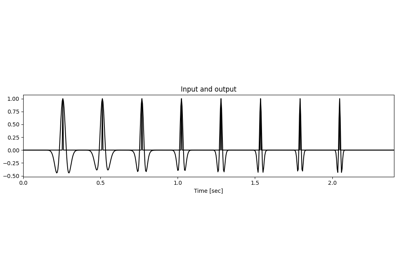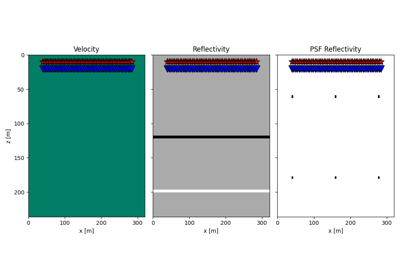pylops.signalprocessing.NonStationaryConvolve2D#
- class pylops.signalprocessing.NonStationaryConvolve2D(dims, hs, ihx, ihz, engine='numpy', num_threads_per_blocks=(32, 32), dtype='float64', name='C')[source]#
2D non-stationary convolution operator.
Apply non-stationary two-dimensional convolution. A varying compact filter is provided on a coarser grid and on-the-fly interpolation is applied in forward and adjoint modes. Both input and output have size \(n_x \times n_z\).
- Parameters
- dims
listorint Number of samples for each dimension (which we refer to as \(n_x \times n_z\)).
- hs
numpy.ndarray Bank of 2d compact filters of size \(n_{\text{filts},x} \times n_{\text{filts},z} \times n_{h,x} \times n_{h,z}\). Filters must have odd number of samples and are assumed to be centered in the middle of the filter support.
- ihx
tuple Indices of the x locations of the filters
hsin the model (and data). Note that the filters must be regularly sampled, i.e. \(dh_x=\text{diff}(ihx)=\text{const.}\)- ihz
tuple Indices of the z locations of the filters
hsin the model (and data). Note that the filters must be regularly sampled, i.e. \(dh_z=\text{diff}(ihz)=\text{const.}\)- engine
str, optional Engine used for spread computation (
numpy,numba, orcuda)- num_threads_per_blocks
tuple, optional Number of threads in each block (only when
engine=cuda)- dtype
str, optional Type of elements in input array.
- name
str, optional Name of operator (to be used by
pylops.utils.describe.describe)
- dims
- Raises
- ValueError
If filters
hshave even size- ValueError
If
ihxorihzis not regularly sampled- ValueError
If
ihxorihzare outside the bounds defined bydims- NotImplementedError
If
engineis neithernumpy,fftw, norscipy.
Notes
The NonStationaryConvolve2D operator applies non-stationary two-dimensional convolution between the input signal \(d(x, z)\) and a bank of compact filter kernels \(h(x, z; x_i, z_i)\). Assuming an input signal composed of \(N \times M\) samples (with \(N=4\) and \(M=3\), and filters at locations \(x_1, x_3\) and \(z_1, z_3\), the forward operator can be represented as follows:
\[\begin{split}\mathbf{y} = \begin{bmatrix} \hat{h}_{(0,0),(0,0)} & \cdots & h_{(1,1),(0,0)} & \cdots & \hat{h}_{(2,2),(0,0)} & \cdots \\ \hat{h}_{(0,0),(0,1)} & \cdots & h_{(1,1),(0,1)} & \cdots & \hat{h}_{(2,2),(0,0)} & \cdots \\ \vdots & \ddots & & \ddots & \vdots & \vdots \\ \hat{h}_{(0,0),(4,3)} & \cdots & h_{(1,1),(4,3)} & \cdots & \hat{h}_{(2,2),(0,0)} & \cdots \\ \end{bmatrix} \begin{bmatrix} x_{0,0} \\ \vdots \\ x_{0,N} \\ x_{1,0} \\ \vdots \\ x_{1,N} \\ x_{M,0} \\ \vdots \\ x_{M,N} \end{bmatrix}\end{split}\]where \(\mathbf{h}_{(1,1)} = [h_{(1,1),(0,0)}, h_{(1,1),(0,1)}, \ldots, h_{(1,1),(4,3)}]\) (and \(\mathbf{h}_{(1,1)}\), \(\mathbf{h}_{(1,3)}\), \(\mathbf{h}_{(3,1)}\), \(\mathbf{h}_{(3,3)}\)) are the provided filter, \(\hat{\mathbf{h}}_{(0,0)} = \mathbf{h}_{(1,1)}\) and similar are the filters outside the range of the provided filters (which are extrapolated to be the same as the nearest provided filter) and \(\hat{\mathbf{h}}_{(2,2)} = \text{bilinear}(\mathbf{h}_{(1,1)}, \mathbf{h}_{(3,1)}, \mathbf{h}_{(1,3)},\mathbf{h}_{(3,3)})\) is the filter within the range of the provided filters (which is bilinearly interpolated from the four nearest provided filter on either side of its location).
For more details on the numerical implementation of the forward and adjoint, see
pylops.signalprocessing.NonStationaryConvolve1D.- Attributes
- shape
tuple Operator shape
- explicit
bool Operator contains a matrix that can be solved explicitly (
True) or not (False)
- shape
Methods
__init__(dims, hs, ihx, ihz[, engine, ...])adjoint()apply_columns(cols)Apply subset of columns of operator
cond([uselobpcg])Condition number of linear operator.
conj()Complex conjugate operator
div(y[, niter, densesolver])Solve the linear problem \(\mathbf{y}=\mathbf{A}\mathbf{x}\).
dot(x)Matrix-matrix or matrix-vector multiplication.
eigs([neigs, symmetric, niter, uselobpcg])Most significant eigenvalues of linear operator.
matmat(X)Matrix-matrix multiplication.
matvec(x)Matrix-vector multiplication.
reset_count()Reset counters
rmatmat(X)Matrix-matrix multiplication.
rmatvec(x)Adjoint matrix-vector multiplication.
todense([backend])Return dense matrix.
toimag([forw, adj])Imag operator
toreal([forw, adj])Real operator
tosparse()Return sparse matrix.
trace([neval, method, backend])Trace of linear operator.
transpose()

